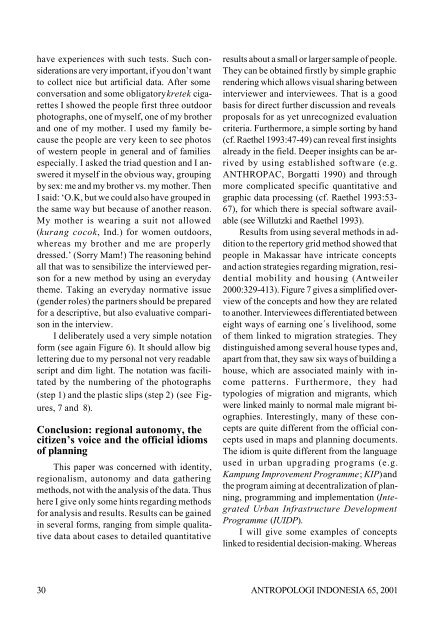Transethnic Identity and Urban Cognition in Makassar: - Antropologi ...
Transethnic Identity and Urban Cognition in Makassar: - Antropologi ...
Transethnic Identity and Urban Cognition in Makassar: - Antropologi ...
Create successful ePaper yourself
Turn your PDF publications into a flip-book with our unique Google optimized e-Paper software.
have experiences with such tests. Such considerations<br />
are very important, if you don’t want<br />
to collect nice but artificial data. After some<br />
conversation <strong>and</strong> some obligatory kretek cigarettes<br />
I showed the people first three outdoor<br />
photographs, one of myself, one of my brother<br />
<strong>and</strong> one of my mother. I used my family because<br />
the people are very keen to see photos<br />
of western people <strong>in</strong> general <strong>and</strong> of families<br />
especially. I asked the triad question <strong>and</strong> I answered<br />
it myself <strong>in</strong> the obvious way, group<strong>in</strong>g<br />
by sex: me <strong>and</strong> my brother vs. my mother. Then<br />
I said: ‘O.K, but we could also have grouped <strong>in</strong><br />
the same way but because of another reason.<br />
My mother is wear<strong>in</strong>g a suit not allowed<br />
(kurang cocok, Ind.) for women outdoors,<br />
whereas my brother <strong>and</strong> me are properly<br />
dressed.’ (Sorry Mam!) The reason<strong>in</strong>g beh<strong>in</strong>d<br />
all that was to sensibilize the <strong>in</strong>terviewed person<br />
for a new method by us<strong>in</strong>g an everyday<br />
theme. Tak<strong>in</strong>g an everyday normative issue<br />
(gender roles) the partners should be prepared<br />
for a descriptive, but also evaluative comparison<br />
<strong>in</strong> the <strong>in</strong>terview.<br />
I deliberately used a very simple notation<br />
form (see aga<strong>in</strong> Figure 6). It should allow big<br />
letter<strong>in</strong>g due to my personal not very readable<br />
script <strong>and</strong> dim light. The notation was facilitated<br />
by the number<strong>in</strong>g of the photographs<br />
(step 1) <strong>and</strong> the plastic slips (step 2) (see Figures,<br />
7 <strong>and</strong> 8).<br />
Conclusion: regional autonomy, the<br />
citizen’s voice <strong>and</strong> the official idioms<br />
of plann<strong>in</strong>g<br />
This paper was concerned with identity,<br />
regionalism, autonomy <strong>and</strong> data gather<strong>in</strong>g<br />
methods, not with the analysis of the data. Thus<br />
here I give only some h<strong>in</strong>ts regard<strong>in</strong>g methods<br />
for analysis <strong>and</strong> results. Results can be ga<strong>in</strong>ed<br />
<strong>in</strong> several forms, rang<strong>in</strong>g from simple qualitative<br />
data about cases to detailed quantitative<br />
results about a small or larger sample of people.<br />
They can be obta<strong>in</strong>ed firstly by simple graphic<br />
render<strong>in</strong>g which allows visual shar<strong>in</strong>g between<br />
<strong>in</strong>terviewer <strong>and</strong> <strong>in</strong>terviewees. That is a good<br />
basis for direct further discussion <strong>and</strong> reveals<br />
proposals for as yet unrecognized evaluation<br />
criteria. Furthermore, a simple sort<strong>in</strong>g by h<strong>and</strong><br />
(cf. Raethel 1993:47-49) can reveal first <strong>in</strong>sights<br />
already <strong>in</strong> the field. Deeper <strong>in</strong>sights can be arrived<br />
by us<strong>in</strong>g established software (e.g.<br />
ANTHROPAC, Borgatti 1990) <strong>and</strong> through<br />
more complicated specific quantitative <strong>and</strong><br />
graphic data process<strong>in</strong>g (cf. Raethel 1993:53-<br />
67), for which there is special software available<br />
(see Willutzki <strong>and</strong> Raethel 1993).<br />
Results from us<strong>in</strong>g several methods <strong>in</strong> addition<br />
to the repertory grid method showed that<br />
people <strong>in</strong> <strong>Makassar</strong> have <strong>in</strong>tricate concepts<br />
<strong>and</strong> action strategies regard<strong>in</strong>g migration, residential<br />
mobility <strong>and</strong> hous<strong>in</strong>g (Antweiler<br />
2000:329-413). Figure 7 gives a simplified overview<br />
of the concepts <strong>and</strong> how they are related<br />
to another. Interviewees differentiated between<br />
eight ways of earn<strong>in</strong>g one´s livelihood, some<br />
of them l<strong>in</strong>ked to migration strategies. They<br />
dist<strong>in</strong>guished among several house types <strong>and</strong>,<br />
apart from that, they saw six ways of build<strong>in</strong>g a<br />
house, which are associated ma<strong>in</strong>ly with <strong>in</strong>come<br />
patterns. Furthermore, they had<br />
typologies of migration <strong>and</strong> migrants, which<br />
were l<strong>in</strong>ked ma<strong>in</strong>ly to normal male migrant biographies.<br />
Interest<strong>in</strong>gly, many of these concepts<br />
are quite different from the official concepts<br />
used <strong>in</strong> maps <strong>and</strong> plann<strong>in</strong>g documents.<br />
The idiom is quite different from the language<br />
used <strong>in</strong> urban upgrad<strong>in</strong>g programs (e.g.<br />
Kampung Improvement Programme; KIP) <strong>and</strong><br />
the program aim<strong>in</strong>g at decentralization of plann<strong>in</strong>g,<br />
programm<strong>in</strong>g <strong>and</strong> implementation (Integrated<br />
<strong>Urban</strong> Infrastructure Development<br />
Programme (IUIDP).<br />
I will give some examples of concepts<br />
l<strong>in</strong>ked to residential decision-mak<strong>in</strong>g. Whereas<br />
30 ANTROPOLOGI INDONESIA 65, 2001


